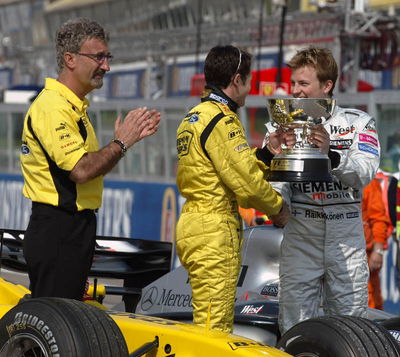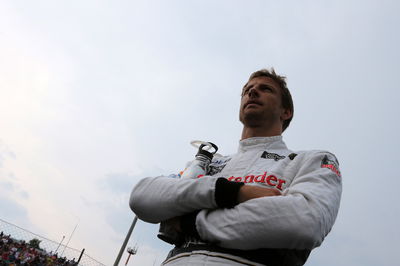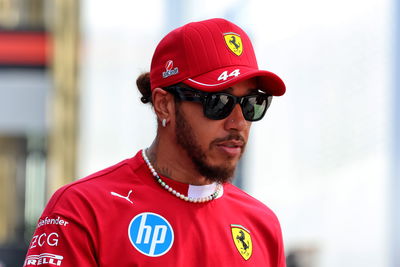Six of the Best: Tales from the podium

From the wreaths, garlands, sashes and beauty queens of yore to the choreographed corporate parade of suits and platitudes we see today, the Formula One podium has changed beyond all recognition over the years.
Anthems and champagne aside, one enduring trait is the occasional propensity for the unexpected. In the past, mishaps such as Alan Jones being serenaded with Happy Birthday rather than the Australian national anthem after his maiden win at the 1977 Austrian GP, or the sight of Gilles Villenueve spraying Labatt's beer instead of champagne from the podium after winning the 1978 Canadian GP added a degree of colloquial quirkiness to what was traditionally an informally haphazard affair.
As the podium has been sanitised down the years to become another extension of Formula One's corporate visage, such quirks have been somewhat quashed - making mishaps such as Eddie Irvine being greeted with the Irish flag on the podium at the 1997 Argentine GP, Bernie Ecclestone personally buying the champagne for the 1997 French GP podium after a ban on all alcohol on television meant the race organisers hadn't supplied any bubbly, the Jerez mayor crashing the 1997 European GP podium, or Michael Schumacher and Rubens Barrichello's controversially awkward position swap at the 2002 Austrian Grand Prix, all the more memorable.
That's not to say that the podium can't still be interesting though - and it's a remarkable event at last year's Belgian GP that kickstarts Crash.net's look at some of the most extraordinary podium incidents of recent years.
2013 BELGIAN GP
Formula One races have famously been disrupted by protests in the past, most notoriously by lone ranger track invasions at the 2000 German GP and the 2003 British GP, but last year's Belgian race saw a grand prix targeted by a pre-meditated protest campaign for the first time - with the most visual results secured through a daring escapade on the podium.
The incompatibility of Greenpeace's ethos with the culture of Formula One is fairly obvious, but the events at Spa saw Greenpeace ignore the wider anti-green credentials of the sport to exact a guerrilla campaign against Belgian GP title sponsor Shell and their Arctic drilling programme.
The protest entailed several activations during the race, with an enormous banner unfurled over the main grandstand on the start/finish straight and two activists scaling a Shell billboard at Radillon. Each transgression was steadfastly ignored by the FOM global TV feed, but the 35-strong Greenpeace delegation had special plans for the podium ceremony.
As the top three drivers appeared to collect their trophies, two remote-controlled banners, installed some weeks before, were unfurled in sequence - leading to the comedic sight of an FOM suit scruffily disposing of one banner and walking back to his station as the second banner appeared in pantomime 'behind you' fashion - with the unedifying spectacle broadcast to the world.
Simultaneously, two protestors attempted to abseil down from a small roof above the podium. One was apprehended by security whilst the second was able to unfurl yet another banner, causing vociferous boos from the crowd - much to the confusion of race-winner Sebastian Vettel.
The podium incident finally succeeded in generating TV exposure for the protest, but with the unfortunate side effect of delivering the kind of brand visibility for Shell that most F1 sponsors would kill for. Before the race few would have been able to identify the Belgian GP's title sponsor, but after Greenpeace's podium sabotage few were left in any doubt that Shell were the race's primary partner - although presumably the brand managers would have been a lot happier had their activities not been explicitly linked to the destruction of the Arctic...
1993 AUSTRALIAN GRAND PRIX
The F1 podium's requirement for an instant public parade of post-event emotion is unusual in sport, and inevitably with passions and adrenaline running high displays of extreme joy or, on occasion, disappointment, are to be expected.
An epochal emotional act to bury the most infamous hatchet in racing history is something else altogether though. Reconciliation is a rare enough deed in Formula One as it is, but Ayrton Senna's touching gesture of appeasement to great rival Alain Prost on the podium at the 1993 Australian Grand Prix has become one of F1's most moving memories.
Prost's swansong season had been a cakewalk to his fourth and final championship, the performance of the Williams-Renault FW15 giving the Frenchman an advantage that even Senna's brilliance couldn't overcome. At the final race of the season in Australia, with Prost set to hang up his helmet and Senna confirmed to replace his him at Williams for 1994, the two titans appropriately finished 1-2, with Senna taking a 41st Grand Prix victory on his last appearance for McLaren.
As the drivers were handed their trophies on the podium, Senna, in a seemingly spontaneous gesture, held Prost's arm aloft before pulling him up to share the top step of the rostrum in a warm embrace. Given the hostile and heated history between the two, it was a sensational moment. The action alluded to a thawing of relations, as surmised by Senna post-race; "the attitude there speaks for itself. It was reflected in my feeling and his feeling, too".
The podium gesture marked the start of a d?tente that would endure through the remaining months of Senna's life. It was as if the now-retired Prost was no longer worthy of antagonism after the final act in the rivalry that had defined them both, and Senna later admitted that he only subsequently realised how much of his motivation had come from fighting with Prost.
One further touching moment at the 1994 San Marino GP reflected the cautiously blossoming friendship between Senna and Prost. Filming an on-board lap commentary for French TV channel TF1, for whom Prost was acting as a pundit, Senna offered "a special hello to my... to our dear friend Alain. We all miss you, Alain." It was a tender acknowledgement laced with premonitory poignancy, as barely a week later Prost would act as a pallbearer at Senna's funeral.
2006 TURKISH GP
Politics and Formula One have always been uneasy bedfellows, and despite the Machiavellian machinations, grandstanding and manouvering within the 'Pirhana Club', the paddock has generally professed to be blind, deaf and dumb when external affairs have threatened the political neutrality of the sport.
That's not to say that Formula One isn't ever used as a political weapon or as a plaything to demonstrate the international standing of its host nations though. For many countries, the eyes of the world and the attention attracted by F1 are an opportunity to show off or make a grand statement on the global stage.
The 2006 Turkish Grand Prix saw this maxim taken a step too far though, with a game of political subterfuge played out on the post-race podium in front of a global audience of hundreds of millions. Race winner Felipe Massa was presented with his trophy by one Mehmet Ali Talat, introduced by announcers as the President of the Northern Turkish Republic of Cyprus.
Whilst there's nothing new about a head of state presenting a race trophy, if you try looking for the Turkish Republc of Northern Cyprus on a map, you'll be rummaging around for a while - no such country exists, except in the eyes of Turkey. The territory referred to in Talat's title is an area of Cyprus - the Mediterranean island over which Greece and Turkey have fought for centuries.
The Istanbul Chamber of Commerce later admitted that they had withheld the identity of their presentation party until the last minute to ensure that the FIA couldn't veto the choice. Furious that their political neutrality had been compromised, the FIA fined the race organisers $5m.
Although it was the heaviest fine ever administered by the FIA, it was still seen as something of a weak response and, when assessed through a realpolitik lens, it's easy to see why: cost of constructing the Istanbul Park circuit: $150m, cost of annual race fees to FOM: $25m, cost of fine for breaching FIA's political neutrality: $5m. Telling the world that the Northern part of Cyprus is a Turkish territory on live TV: priceless.
2013 MALAYSIAN GP
The 'new' podium procedure of uniform backdrop, electronic flags and publicly visible driver interviews has received mixed reviews since its inception at the 2012 British Grand Prix. For all the positive intentions behind giving fans at the circuit an opportunity to see and engage with their heroes, incidents such as the 2012 Abu Dhabi Grand Prix's 'sweargate' and the fans' barracking of Vettel during the 2013 season, not to mention a litany of dull interviews conducted by ill-qualified celebrity guests, have shown that the format is at best a work in progress.
The one occasion where the driver interviews proved an electric piece of must-see television was after the controversial 2013 Malaysian Grand Prix, when an emotionally charged Mark Webber publicly admonished the Red Bull team and his team-mate Sebastian Vettel.
Vettel had defied team orders to pass Webber for the lead of the race on lap 44, earning him a middle finger of retribution from the Australian and a rebuke over team radio en route to a contentious victory. In the pre-podium room, Webber gave Vettel a death stare and repeated the now infamous mantra of 'Multi 21' before the pair, flanked by an equally glum Lewis Hamilton - who was embroiled in a team orders dispute of his own - headed onto the most subdued podium in recent memory.
When the champagne was popped, the Red Bull drivers turned their backs on each other, before Webber steadfastly refused to put his arm around Vettel for the traditional winners' photo. The real drama was yet to come though, as a straight-talking Webber publicly laid into Vettel and Red Bull during his interview with Martin Brundle, stating; "in the end Seb made his own decisions today, not respected team orders, but will have protection as usual".
Vettel's actions caused the final irreparable schism in an intra-team rivalry that bristled with on- and off-track tension across five seasons. Webber's podium criticism of Vettel and all-round good guy demeanour made taking sides a fairly simple proposition for most fans - but Vettel would doubtless argue that the moral high ground has never offered as gratifying a view as the top step of the rostrum.
1989 ITALIAN GRAND PRIX
Outdating even champagne as part of the podium celebrations, trophies have been the enduring barometer of success in motorsport since the first ever automobile races. They're an eternal currency all drivers and teams can relate to, with their sentimental value, not to mention their ability to fill factory trophy cabinets and mantlepieces, highly prized.
These days, almost all drivers have clauses in their contracts stipulating that the team owns all race trophies - with replicas cast at the drivers' personal expense. The first team to instigate this policy was, unsurprisingly, McLaren at the start of the Ron Dennis era - with Big Ron's desire for autonomous control extending to ownership of any silverware won at the wheel of a McLaren.
Dennis was furious when one of the prizes won from Alain Prost and Niki Lauda's 1-2 finish at the 1984 German GP went missing in the post-podium celebrations, and from that day assigned team co-ordinator Jo Ramirez to manage the collection of McLaren's trophies.
Ahead of the 1989 Italian Grand Prix, Prost announced that he was leaving to join Ferrari for the 1990 season. His relationship with McLaren had deteriorated over the course of two fractious seasons partnering Ayrton Senna, and Prost's feelings were epitomized by an almost comical 'flipping the bird' podium gesture to Ron Dennis.
After winning the race, Prost, taking the acclaim of a newly adoring Tifosi on the podium, heard the chants of 'Copa Copa' from below and duly obliged, dropping the trophy into the crowd - where it was summarily ripped to pieces by the jubilant fans. Dennis, flanking Prost on the podium, had turned in horror movie slow motion to see the trophy fall - and was absolutely furious at both Prost's defiance of tradition and the loss of his storied prize. Dennis stormed off the podium and Prost was later forced to make an apology, but the damage had been done.
A replica was eventually made, but it wasn't presented to Dennis until six years later, when relations had thawed and Prost was working as a consultant at McLaren. The trophy remains the most infamous outstanding item in McLaren's glittering collection - and not even Ron Dennis' collectors' instinct (or chequebook) will ever be able to resurrect the original.
2003 BRAZILIAN GRAND PRIX
With the podium such a carefully choreographed charade, it's perfectly understandable to enjoy the occasions it goes entirely wrong as something of a guilty pleasure. One notorious example of unconventional podium etiquette was the 2003 Brazilian Grand Prix, when events contrived to leave none of the top three finishers standing in position on the rostrum at race's end.
The race was an all-time classic, with torrential rain putting the 'lakes' in Interlagos and causing a lottery of track conditions. There had been multiple crashes, leaders and overtakes, and on lap 53 race leader David Coulthard's McLaren had just pitted for the final time, leaving team-mate Kimi Raikkonen duelling for the lead with the surprisingly fast Jordan of Giancarlo Fisichella.
At the end of lap 53, a huge crash for Mark Webber's Jaguar on the start-finish straight sprayed debris across the track and instigated a Safety Car period. However, before the Safety Car could pick up the leaders, third-placed Fernando Alonso failed to slow for the incident and slammed into the wreckage, destroying his Renault against the tyre wall and leaving the circuit blocked with car parts and fragments of barriers.
With the track impassable, the red flag was thrown and the race was stopped with Fisichella leading. Eddie Jordan celebrated wildly, but as the drivers emerged on the podium, it was Raikkonen who took the top step. The result had been awarded on countback to the start of the previously completed lap, in this instance lap 53, which Raikkonen had led. Missing from the celebrations was Alonso - classified third despite his accident causing the end of the race - who was being checked out in hospital due to the severity of his accident, ensuring the bizarre sight of a two-man podium.
Ahead of the San Marino GP, the race results were amended, with a legal challenge from Jordan pointing out that Fisichella had started his 56th lap before the red flag signal was given, meaning that the countback should be to the start of lap 54 - which Fisichella had led. On the Friday morning at Imola, an unusual second trophy presentation took place, with Raikkonen and Ron Dennis handing the trophies to Fisichella and Jordan in front of an emptily bemused main grandstand. It had been a bizarre maiden victory for Fisichella, capped off with a completely unique non-podium trophy presentation.











